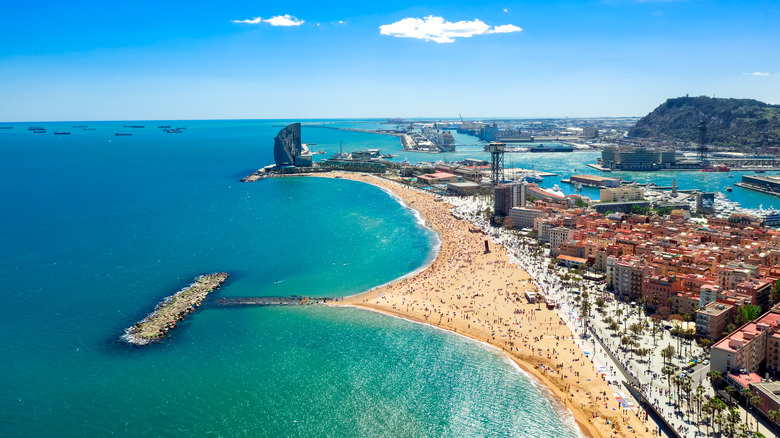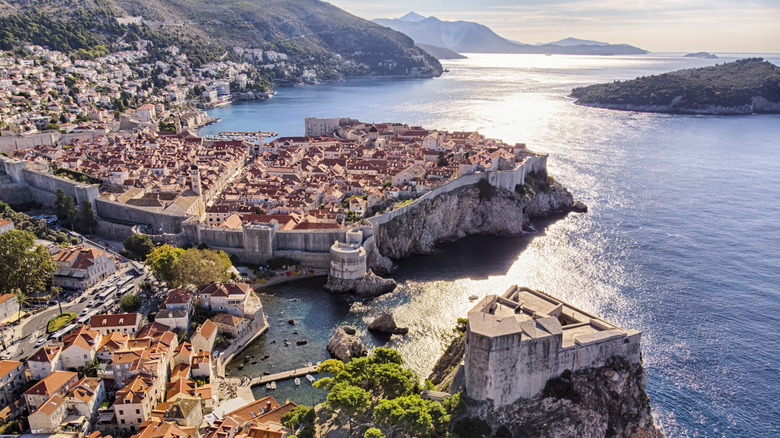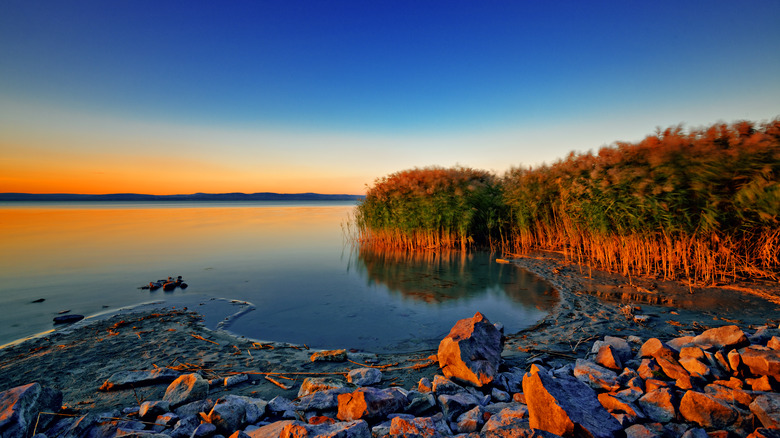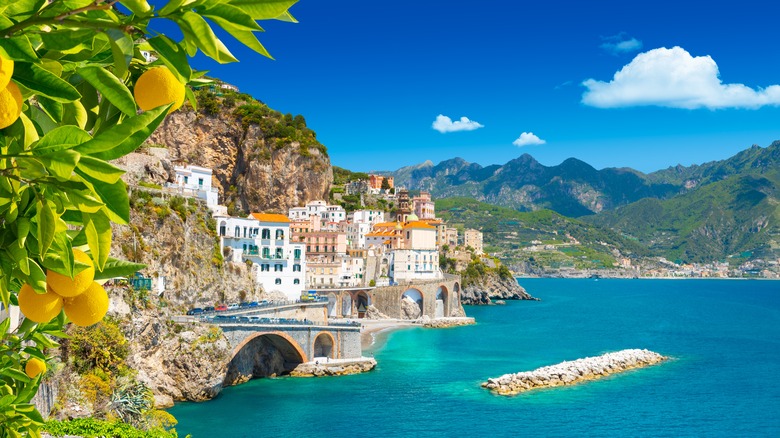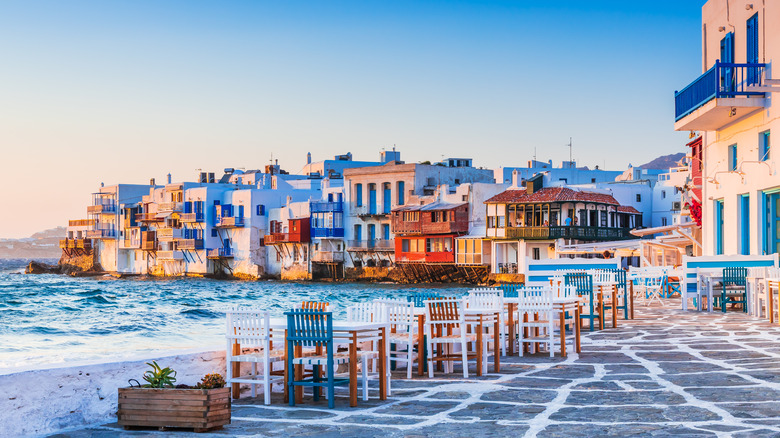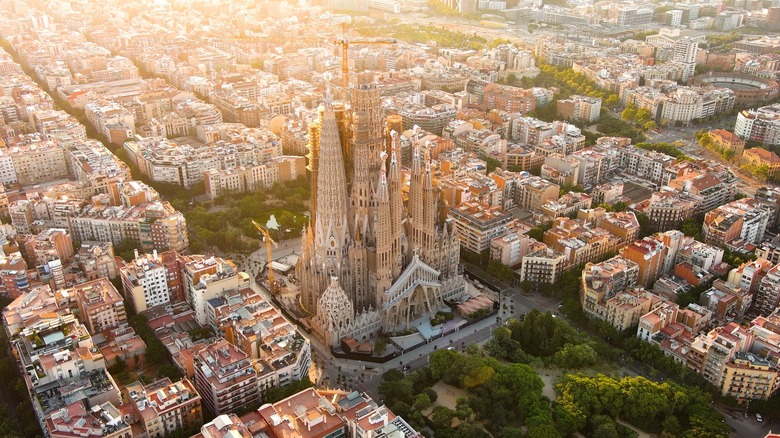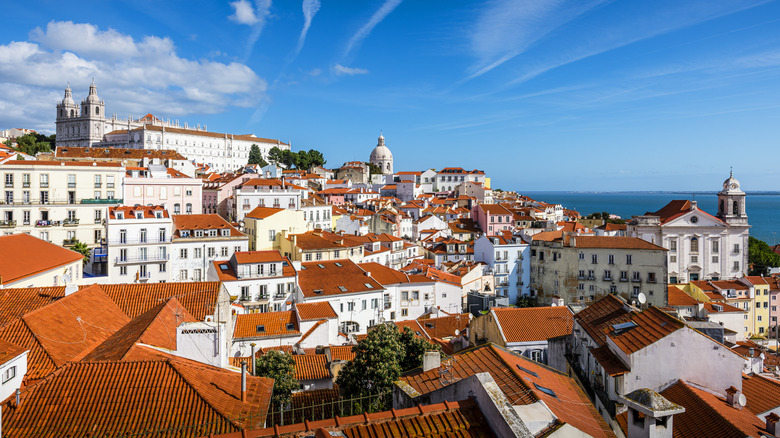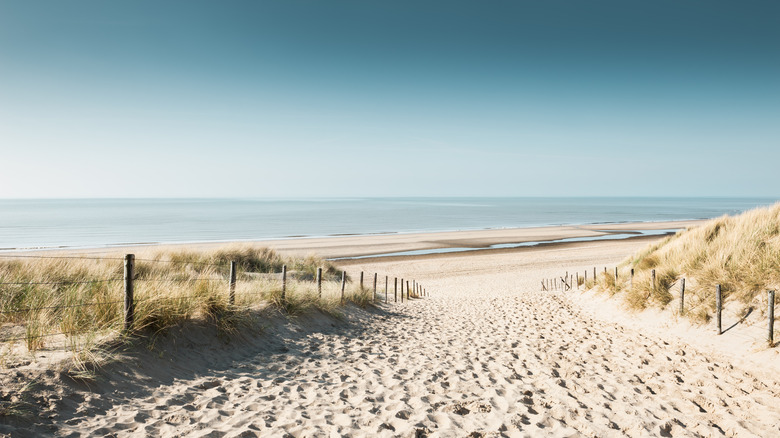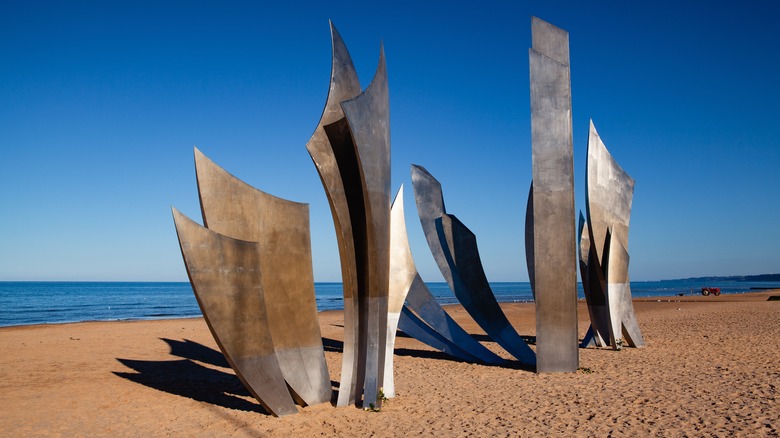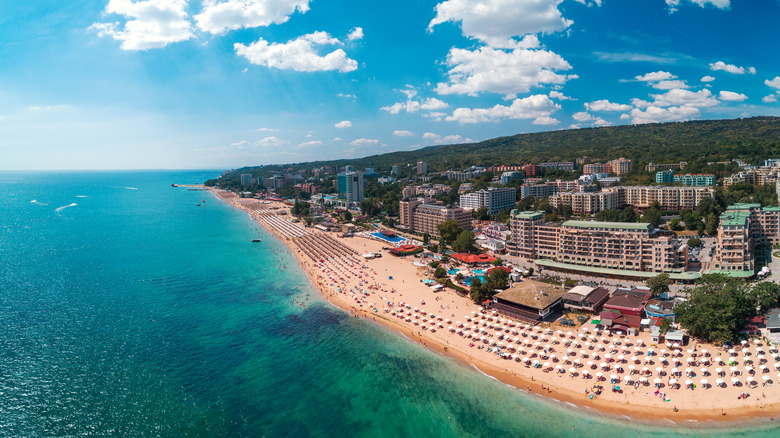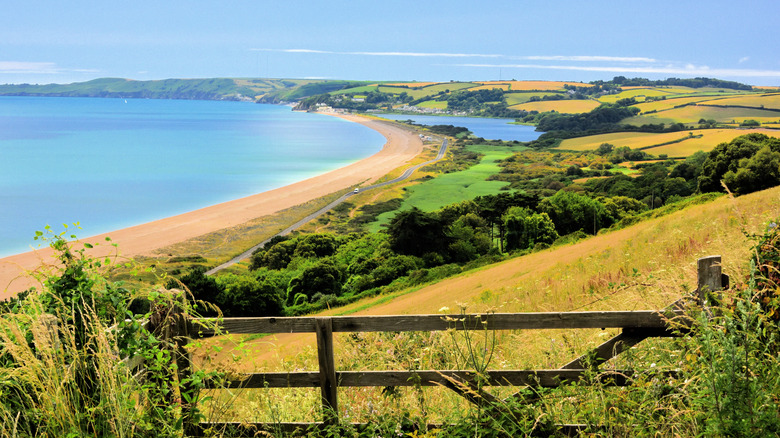Avoid These Destinations When Booking Your Next European Beach Vacation
For such a small continent, Europe has quite a diverse array of beach options that range from the astonishing to surprising to the not-so-great. The wild Atlantic coast winds along Ireland, the Netherlands, Belgium, France, Spain, and Portugal. The Mediterranean which runs from the south of Spain and France all the way through the Balkans and Greece is always a crowd favorite. And the less thought-of Black Sea and sandy shores along Europe's lakes make for amazing getaways along the water. This is an overwhelming amount of choice for travelers hoping to catch some rays (or waves) and indulge in a relaxing trip to one of the region's numerous waterside destinations.
It is very important to choose carefully to ensure you have the best trip possible. There's nothing worse than a disappointing holiday. And here's a little secret that is infrequently discussed — not all beaches are spectacular just because there are crashing waves and sandy (or rocky) shores. From overcrowding to skyrocketing prices and contaminated water, you should thoroughly research potential locations. That's why we've rounded up 12 European beach destinations you should avoid for various reasons when planning your next vacation. We've also included alternatives to help you plan.
Nice, France
The quintessential "French Riviera" destination is actually quite overrated for many reasons. Sure, the pastel-colored buildings, cheap (but amazing) wine, and decades-long glamor are great grounds to plan a visit. However, while no one goes to the Côte d'Azur to have a budget-friendly holiday, prices in Nice have only continued to rise with inflation and recovery from the pandemic. The same could be said for much of France (particularly cities and towns along the coast) but these days, it's hard to justify the cost when it comes to value. Nice is nice, but not a once-in-a-lifetime location like Santorini or Mont-St-Michel up north.
There are many coastal cities with brightly colored structures and quality food and drink up and down the Mediterranean. Several of which are cheaper and don't have the crowds of Nice. Additionally, the main beach consists of giant pebbles — not exactly the white sand many travelers hope for on a dream trip. Nice is a good entry point to the South, either by plane or train, so spend a day or two checking it out if you've never been. But then head elsewhere, the area is full of amazing places to discover! Menton, right next to Italy has blissfully flown under the radar and is an adorable coastal town just a 35 to 40-minute train ride from Nice. Alternatively, Eze, located a little over an hour from Nice, has some truly special beaches and corners to discover.
Dubrovnik, Croatia
Croatia's most popular city has that reputation for two main points. First, "Game of Thrones" put it on the map for international travelers, particularly Americans, and this effect hasn't really ever gone away. Second, it is a beautiful city with unique architecture and viewpoints you won't find elsewhere in the country. However, the town's popularity has its downsides. Dubrovnik is always full of visitors, especially during the summer, which is, of course, the best time to hit the beach. It also hosts a large number of cruise ships from May through August, which means it is even more crowded with day-trippers during the warm months. All of this, combined with Croatia joining the EU, Schengen zone, and Eurozone has taken a toll on visitors' wallets. The country definitely isn't a "budget destination" anymore and prices have jumped significantly in large cities like this one.
Additionally, within the city, there are few beach access points, most of which require scaling down a rocky path or cliff to reach. Yes, the entire coastline of Croatia is public by law (unlike elsewhere in the Balkans), so you'll never have to pay a beach club or entry fee. However, there are much better places to enjoy the Adriatic! Try cool and off-beat Zadar up the coast or for something a bit different, the Istria peninsula where you can indulge in truffles!
Ibiza, Spain
Long known as a party island, Ibiza is a fantastic place if you're young and want to go out all night and sleep through most of the day. It's also quite expensive, which is why the rich and famous frequent it, but for the average holiday goer, centrally located accommodation, club covers, and meals will be quite steep. You may be tempted to save some cash by staying somewhere less central, but don't forget Ibiza is a much larger island than many anticipate. Thus, it can be a hike or at least an expensive cab ride to the town or beaches. Additionally, renting a car is a smart idea due to the island's size, especially if you want to explore and/or aren't staying right in town. However, a vehicle becomes impractical if you choose to drink or indulge at one of the infamous Ibiza clubs, which you likely will do if you choose this as your ideal vacation. Also, note that clubs here are crowded and expensive.
Additionally, because partying is the main draw, that will be the main social activity, not the beaches. You can also find better sandy shores elsewhere in Spain. Instead, try the neighboring island, Formentera. There is no airport so you'll need to take a boat from Ibiza. So you can fly into Ibiza and check it out for a night to see what all the fuss is about, before heading to Formentera, the best of both worlds, that prioritizes relaxation.
Lake Balaton, Hungary
Lake Balaton has been nicknamed "Hungary's Sea" due to its size and numerous resorts and vacation rentals along its shores. The destination has long been popular with vacationers. However, in recent years, water quality concerns and algae issues have been raised by state monitors. So it might be a good idea to reconsider it as a beach destination, at least anytime soon. And as climate change continues to wreak havoc on our planet, the toxic algae blooms likely won't improve without action. All of this is a complete shame as Hungary's largest lake is a site for the eyes.
You can visit, just refrain from dipping your toes (or much more) in the water. If you're looking to relax and refresh in the country, head to Budapest instead and soak in the world-famous baths which are full of health-promoting minerals. Then, either set off on a cruise or settle into a holiday rental along the much cleaner Danube.
Amalfi Coast, Italy
The Amalfi Coast is on most traveler's wishlists and if you have limited time in Italy, can take priority over many other locations. The Mediterranean views are out of this world and the towns do boggle the mind, brightly colored buildings built into the cliffs. Not to mention the inhabitants whose daily walks and commutes take them up and down numerous stairs and steep hills. However, as a beach vacation, you can do better. The Amalfi beaches are overrated, overpriced, and overcrowded in summer, the best time to visit for holidays along the Med.
Transportation here can also be a bit of a nightmare, as there is no train. So you'll be in thick traffic most of the time. Driving is a stressful endeavor for even the coolest drivers as the roads here are terrifyingly narrow and run along straight cliffs. The bus doesn't fare much better in terms of traffic and road comfort, but at least you won't be behind the wheel and you'll save quite a bit. The views and towns are beautiful but not to the point of justifying the price nor are they so much better than other parts of Italy. Head elsewhere if you want a sandy shore vacation, like Sardinia or Sicily. If you do visit Amalfi, the way to do it without crowds or stress or (much) money is to hike the "Path of the Gods". Start in Bomerano and follow the just-under 4-mile path along the Med for stunning panoramas.
Mykonos, Greece
Similar to its Spanish cousin Ibiza, Mykonos is predominantly a party island whose beaches and surrounding nature simply don't justify the much higher price tag. As part of the Cyclades island chain, it's even more disappointing. It would be difficult for any place to compete with sunsets over whitewashed Santorini or the verdant forests against the electric waters of Naxos. Of course, any Greek isle will be magical, the sparkling Mediterranean, cute towns, and ancient ruins ensure that fact. However, Mykonos really does not hold a candle to the neighboring islands. The beaches are nice, but nothing like the idyllic coves of Milos or quiet respites that make up Sifnos' shores.
The quaint main town is pleasant to wander but it can become unbearably crowded. If you think Oia on Santorini is bad, Mykonos Town is on another level. Transportation isn't great, not unlike other Greek holiday destinations, but again, when you're paying a premium price, this becomes less tolerable. Additionally, reservations are required virtually everywhere — bars, restaurants, beach clubs, so don't expect to be able to pull off anything spontaneously. And as mentioned before, Mykonos is noticeably more expensive than most other destinations in Greece. The only other location that comes close is Santorini where the views and island as a whole make the cost sting much less. If you're looking for a better holiday experience in Greece, try any other island in the Cyclades.
Barcelona, Spain
In 2018, Barcelona famously put up a giant sign that essentially told tourists to stay away. The resentment came out of a lack of housing (due to platforms like Airbnb and others that promote short-term rentals), overcrowding in residential neighborhoods, and strain on services. Things haven't improved much in the years since, although lockdowns and closed borders did allow for a bit of a break for a couple of years. Now, the sign might be gone, but the less-than-welcoming attitude isn't completely, in fact, as visitor numbers soar past pre-pandemic numbers, locals are understandably perturbed. So, if you want a less busy and friendlier trip, consider a different part of Spain.
Honestly, while Barcelona beaches are nice (especially when you consider that they're right in the city) there are much nicer options not far away. As a bonus, often these destinations have fewer crowds. Calella de Palafrugell is one of Costa Brava's most beautiful areas and multiple beaches line the town, only an hour and a half from Barcelona, depending on traffic. Alternatively head to Ocata, just a 30-minute train ride from the city, but it feels like you're in a completely different world!
Lisbon, Portugal
Famous for near year-round sunshine, the Portuguese capital has become a haven for digital nomads, retirees, and vacationers looking to escape the gray and cold back home. As a result, the city has experienced many of the same issues as Dubrovnik and Barcelona. From overcrowding to increased prices, Portugal, like Croatia, has changed a lot over the past decade. You can still have a nice trip of course, but keep in mind Lisbon's beaches aren't right in the city. You'll need to drive a bit to reach most and at that point, just take your rental car out of the metropolitan area and enjoy the white sand of more tranquil parts of the country.
The Algarve is home to sweeping cliffs and electric blue Atlantic water in the southern portion of Portugal. It is a popular destination but feels much more manageable than the summer crowds in Lisbon. Alternatively, head to Nazare just north of the capital city for some of the best surfing waves in the Atlantic. Or, trade Lisbon for nearby Setubal and take a short ferry to Praia de Troia Mar.
Katwijk, the Netherlands
The Netherlands houses many nice beaches and can be a great place to avoid the high visitor numbers along the Mediterranean. However, don't just show up at any beach in the country and expect to have a great beach day. You'll need to choose carefully as water quality along some of the Dutch coast has been of concern. Additionally, the strong tides can be a major hazard on many beaches in the country and make swimming not only ill-advised but actually quite dangerous. Seafoam can be so treacherous as to cause drowning, even among advanced swimmers and surfers. Take note of the flag system; red means do not go in the water, yellow indicates that you should proceed with caution, an orange windsock means you should leave inflatable floats on the beach due to high winds in the ocean, and an area between two red and yellow flags indicate that it's safe to swim between the flags because lifeguards are monitoring that specific area, according to Veiligstrand.
So if you find yourself in need of a cool-off during a hot Dutch summer, check algae and water reports before you set off, as well as the weather at your destination. Alternatively, you can swim in a canal or lake, just exercise the same precautions as you would at the beach. And never dive into a canal — they're shallower than they appear!
Utah and Omaha, France
The Northwest of France has spectacular destinations to enjoy the shores of the Atlantic, both in Brittany and Normandy. But not every beach is created equal, some are better for learning and others for swimming. The Utah and Omaha beaches are some of the most well-known among Americans due to their significance on D-Day during World War II. So you should absolutely visit on your trip to France, but keep in mind that the day will be less about relaxing on the sand (mostly absent in place of concrete slabs or metal memorials at both beaches) and more about education.
If you want to simply relax in the temperate climate of this area (and sample top-notch seafood), try Deauville, Honfleur, or Le Havre. You'll want to rent a car to get the most out of any trip to this part of France or alternatively, join a day trip from Paris.
Varna, Bulgaria
This Bulgarian town on the Black Sea is popular with both local and international tourists thanks to low prices. So while you won't have the skyrocketing cost to deal with (unlike most destinations on this list) you will experience similar crowds. The Black Sea tourist is different from those along the shores of the Med — i.e. more families than party seekers — but comes in similar quantities. So if you want an off-beat beach vacation in Europe, Varna is certainly an interesting choice, just not one if you want a completely chilled-out holiday.
Another detail to keep in mind is the water quality. Unfortunately, as climate change continues to alter everything about the Earth, more and more destinations, including the beach will be affected. Recently, the water at Bulgarian beaches, including Varna, has been flagged for potentially being less than ideal. This doesn't mean you have to completely avoid that coast, but check the most recent reports before booking a ticket. And if you're looking for an alternative, head to Turkey, where you can still find less crowded places at a decent price.
Devon, UK
Most Brits go abroad in order to have a beach holiday, for a variety of good reasons. Much of southern England is lovely but, as an international tourist, you may want to look elsewhere. Historically, the county of Devon has offered a wonderful expansive slab of shoreline set against rolling green hills that made for the perfectly lovely U.K. staycation. But you may be battling against some dreary weather, depending on the time of year.
It isn't always guaranteed to be nice enough to swim (or even just enjoy a beach day). The odds for good weather are better at other destinations on this list. And despite the sometimes chillier climate, you don't avoid crowds in Devon as it is still popular as ever, despite the recently raised water quality issues. The problem isn't even limited to the southern part of the country, as British beaches are ranked among some of the worst in Europe for clean water. If you want a milder holiday by the sea, try Ireland.
